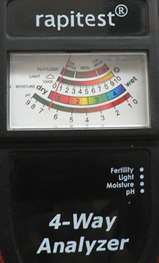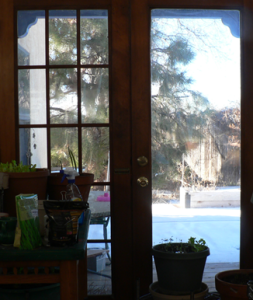12/13/2013 ~ After my Solatube was installed, my friend Del came over, looked at my living room which was definitely brighter and lighter, and said, “It’s too bad it’s not lower.”
And the fact is, it does seem as if the Solatube light is less bright the closer it gets to the floor.
Solatube salespeople assured me, when I was asking pre-buying questions, that the light from the Solatube was the same a foot from the mouth of the Solatube, all the way down to the floor, even if the ceiling was 12 feet high. They said it was the same as being outside: if you stand on a ladder there isn’t more sunlight 6 steps up than there is on the ground. But, while they may believe that Solatube brings in exactly the same sunlight as one gets standing in sunlight outside, I’m not sure that’s what happens.
So, I’m going to buy a light meter. I want to see, among other things, whether raising my pots closer to the mouth of the Solatube, would increase how much light my plants get. I also want to see if the light from the Solatube is such that adding another Solatube would increase overall light for my plants.
This is the lowest cost light meter I found at Amazon. Its reviews are nearly as good as those for one that’s a bit more than twice as expensive.
It’s maximum range is 100,000 lux.
One review noted that this light meter, when placed next to that of an OSHA inspector, registered a lower light level. That is, it was not as exact a reading as that given by a meter costing hundreds of dollars.
For me, since I simply want to compare one area of light to another, I think it will work fine.
[amazon-product alink=”0000FF” bordercolor=”000000″ height=”240″]B005A0ETXY[/amazon-product]This is the more expensive model, which reads up to 200,000 lux.
As an aside, “Lux is a measure of the intensity of light, one Lux is equal to one lumen per square meter. Keep in mind that a Lux reading only measures light intensity to which the human eye is most sensitive (green) and a Lux meter will not measure wavelengths over 580 nm.”
I guess the question is, in determining which meter to buy, “How much light am I dealing with, from a Solatube, in the first place?”
I have this chart on my site:
How much light will Solatube® Provide?
A Solatube® Daylighting System – indeed any tubular daylighting device – works in a similar manner to a window; the brighter the day outside, the more light you receive inside. The table below shows lumen and lux levels that you can expect to receive from a Solatube® Daylighting System under UK weather conditions.
What I don’t understand, is whether the 1388 Maximum Lux output, is more than 100,000 Lux because for some reason some of the zeroes are removed. In which case I’d need to get the 200,000 Lux meter.
I’ve called Solatube and spoken with their wonderful tech, but the tech doesn’t know what the Lux output is, because Solatube doesn’t publish the Lux output, due to the tremendous range given different roof aspects as well as parts of the country. Nevertheless, she will see what she can find, and call me back. My basic question is: Do I need the 100,000 Lux meter, or the 200,00 Lux meter.
Testing the light from Solatube

12/22/2013 ~ I found a small light meter that I ordered years ago because the instrument measures pH, among other things. I wanted to grow blueberries at the time, which need a more acidic soil, hence my need for a pH meter.
When I put up tinfoil in my living room, at the start of trying to get more light to my avocado, the light meter aspect of the instrument showed no improvement in the light, at all. So, I viewed the light meter as not much good. I was putting (or misplacing) my trust in the tinfoil and its supposed ability to increase light to plants, and dismissing information provided by the light meter, when it didn’t coincide with what I believed should be the case. Silly me..
[amazon-product alink=”0000FF” bordercolor=”000000″ height=”240″]B000HHLJQA[/amazon-product]Now, however, when I don’t have the money to buy a new light meter from Amazon, I thought I’d try the little meter again, today: outside in the somewhat cloudy daylight. Sure enough, the needle sprang to life. So, it works.
I set to work analyzing light in the kitchen with its skylight – 1. Living room, on the side far from the Solatube, about .5, as you see in the picture, but in the morning when sunlight comes in the clerestory, it’s 1. I measured the light from my large T5 over my lettuce, collards and onions, and got 3. My GE Plant Light, over the squash pot registered 6, and spread light out to the collards nearest it, at 3. My Solatube, near the large collards, measured less than 1. Sunlight coming in through the French doors to my deck is 2, even though there’s a portal over the door. So, basically, the Solatube is a bust.
Darn it.
12/23/2013 ~ When my squash wasn’t germinating I ordered a GE Plant Light because the light gets quite warm according to the advertising blurb, as well as the reviews on Amazon. In actual fact the earth in the pot with my squash seeds feels quite warm to the touch after the light’s been on for a bit. This is the light that’s giving such a high reading on my little light meter.
[amazon-product alink=”0000FF” bordercolor=”000000″ height=”240″]B0002YXGSC[/amazon-product]The GE Plant Light is 65 watts, so it takes a tad more electricity than two of my full spectrum lamps. The fact it adds more heat than they do is a plus.
The lamp has a keyhole on the back, making it easy to hang. I’m using a board that came with one of my chrome shelves. It looks quite nice and is very sturdy since the pot is holding it in place. There’s an on/off switch on the cord, so it’s easy to reach.
After the light is on for five hours, I turn it off because by then the sun is going down and no longer supporting high electricity use. When I shut the light off I put a clear cover over the pot to conserve the heat.
[amazon-product alink=”0000FF” bordercolor=”000000″ height=”240″]B0026SPXRY[/amazon-product]I’m keen to see how long it is till the seeds come up.
And, this is the chrome shelving unit that supplied the slightly decorative wood board I used for my lamp. The first over-sink chrome shelve came with a sealed board, the last one I ordered came with a bare wood board, which is what you see in the colored picture I took, shown above.
It makes quite a nice looking lamp, don’t you think?
[amazon-product alink=”0000FF” bordercolor=”000000″ height=”240″]B002RIJTSC[/amazon-product]As an aside, if you’re looking for an excellent clear sealer for wood, this is what I used on an outside elevated raised bed, with superb results. I found it after days of looking for something that would give the look of wet wood, without altering the color of the wood. I wanted the shine, but no yellowing.
I found this on a site talking about building a guitar. The pictures of finished guitars were beautiful, so I ordered some and gave it a try. Happily!

12/23/2013 ~ I can’t get rid of the swimming pool blue shadow on the snow. Just to be clear, it’s not a swimming pool.
Prior to taking a light meter reading, I would not have guessed that removing the French door look would result in nearly twice as much light coming through the doors to my deck, even though the doors are under a portal. You can see the corbels to the portal. They’re painted blue. (Which may be causing the blue coloration to the shadow.)
Now I wonder if I should move my candle making table into the corner to the right of the doors, and place large and small pots in front of the door, now that I know there’s more light there than I had appreciated.

